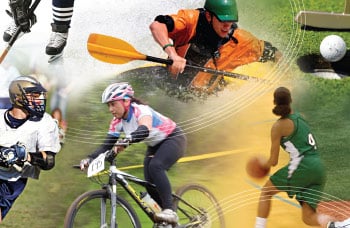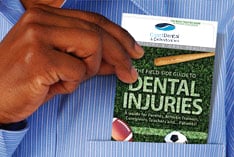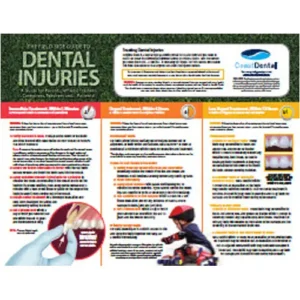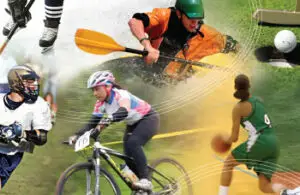A high school basketball player is fighting for a rebound. Suddenly she is struck by the opponent’s elbow and her neck is jerked back and immediately she feels for her mouth. A small amount of blood appears and the certified athletic trainer runs out to assess the injury. Teammates search the floor for either teeth or pieces of teeth, which have been knocked out. Parents watch helplessly from the stands wondering what has happened.
Unfortunately, this is not an unusual scenario. Injuries are a part of sports and injuries in and around the mouth (oral-facial injuries) are very common. This basketball example does however, bring several questions immediately to mind. First, is treatment needed immediately or can it wait? What is the correct immediate and definitive treatment? Can the player keep playing or when can the player return to normal play? Is specific protection necessary for the injured area? Should protection have been provided to this individual before this ever happened? And finally, is my dentist able to answer all of these questions and properly handle sports injuries?
“Oral-facial” injuries can have significant negative functional, esthetic, and psychological effects both on children and adults.
In addition, sports dentistry is concerned with subjects such as smokeless tobacco abuse, nutritional issues such as the erosive potential of sports drinks, substance abuse in athletes and many other topics which can be connected in some way to athletes and their overall health. What should athletes, parents, trainers, coaches and care providers know about sports injuries and their prevention? This article will summarize and answer a few of the many questions, which arose when our fictitious basketball player was injured.
Risky Business
Nobody goes into sports with the idea of intentionally injuring him or herself, but even if not intentional, many injuries are preventable. “Oral-facial” injuries, those involving trauma to the mouth and face, can have significant negative functional, esthetic, and psychological effects both on children and adults.
 Only recently, has greater attention focused on this critical but often overlooked segment of injuries. While oral-facial injuries are rarely life threatening, they can be debilitating and costly over the life of a person. In fact, it’s estimated that over a quarter of dental-related injuries occur while playing sports. A recent study on consumer products and activities associated with dental injuries to children treated in United States emergency rooms between 1990-2003 indicated that:
Only recently, has greater attention focused on this critical but often overlooked segment of injuries. While oral-facial injuries are rarely life threatening, they can be debilitating and costly over the life of a person. In fact, it’s estimated that over a quarter of dental-related injuries occur while playing sports. A recent study on consumer products and activities associated with dental injuries to children treated in United States emergency rooms between 1990-2003 indicated that:
- An average of 22,000 dental injuries annually occurred among children less than 18 years of age.
- Children with primary (baby) teeth, less than 7 years old sustained over half of the dental injuries in activities associated with home furniture.
- Outdoor recreational products and activities were associated with the largest number of dental injuries among children ages 7-12 and almost half of these were associated with bicycles.
- Among children with permanent (adult) teeth age 13-17, sports-related products/activities were associated with the highest number of dental injuries.
- Of all sports, baseball and basketball were associated with the largest number of dental injuries.
Risk Assessment for Sports Injuries
- Low Velocity Non-Contact Sports — Refers to golf, nordic skiing, weight lifting, running, swimming and others where the athletes perform individually at a reasonable speed without contact with others. The risk of dental injury is low.
- High Velocity Non-Contact Sports — When “non-contact” athletes move at high rates of speed, accidents can occur. Examples are bicycling, motocross, skateboarding, skiing and snowboarding. These accidents can be some of the most complicated and severe.
- Contact Sports — Characterized by frequent body to body, or body to equipment (ball) contact. Contact is incidental to the game, not a requirement. Examples of this are basketball, soccer, lacrosse, baseball, and softball. Injuries such as soccer and basketball have been reported at 25% of all athletes surveyed.
- Collision Sports — Contact is an intended and critical part of the game. Examples are American football, ice hockey, rugby and boxing. Without protection, they are most likely to result in oral-facial injuries, making the case for the use of protective devices, which show the best success when used.
General Management
Because optimal treatment results follow immediate assessment and care, dentists have an ethical obligation to ensure that reasonable arrangements for emergency dental care are available. The history, circumstances of the injury, pattern of trauma, and behavior are important to dental health professionals in distinguishing between non-abusive injuries and those from abuse. Dentists and physicians have the responsibility to recognize, determine and either appropriately manage or refer individuals with acute oral traumatic injuries, as dictated by the complexity of the injury and the individual clinician’s training, knowledge, and experience.
Compromised airway (breathing) or suspected loss of consciousness requires further evaluation by a physician. CPR (Cardio-Pulmonary-Resuscitation), heart and breathing support skills, are universal and good to know, and necessary until Emergency Services arrive.
Care for Oral-facial Injuries
To efficiently determine the extent and correctly diagnose injuries to the face, jaws, teeth and associated structures, a systematic approach to trauma is essential. Assessment includes a thorough history, visual and radiographic (x-ray) examination, and physical evaluation. Treatment also takes into consideration the patient’s health and developmental status.
Most sports-related dental injuries can be classified into three broad categories resulting from impacts sustained during play to the soft tissues, the jaws and the teeth themselves:
- Soft tissues — bruises, cuts and lacerations to the lips, cheeks, gums or tongue. These wounds will require careful cleaning and debridement to make sure there are no entrapped pieces of tooth or dirt. If lacerations are extensive, sutures (stitches) may be necessary. If puncture wounds are present antibiotic treatment together with tetanus toxoid shots may be necessary to prevent serious and life threatening infection.
- Jaws — Dislocations of the lower jaw (mandible) and/or fractures of upper or lower jaws. Trauma to structures beyond the teeth and their supporting bone, such as jaw bone fractures will require more complex testing and scanning. Simple jaw dislocations are generally fairly simple to correct. Jaw fractures, depending on extent and location, may necessitate anything from simple fixation or splinting (joining together) of a group or groups of teeth, to open surgical fixation and pinning under general anesthesia. Jaw fractures will usually require more sophisticated imaging techniques to determine the extent and location of fractures to allow the proper methods of repair. They will usually require the skills and expertise of oral maxillofacial surgeons, dentists who have specialized in this area.
Over 80% of all dental injuries involve the upper front teeth.
- Dental — Anything to do with the teeth from crazing or simple chipping, to complex fractures or avulsions (the tooth removed from its socket). More serious conditions occur when the teeth are fractured, a term that refers to a break in the outer protective layers of a tooth, the enamel and dentin. If the fracture is serious enough to expose the tooth’s inner pulp, immediate attention from a dentist will be needed to reduce the risk of losing the tooth, by treating the exposed pulp and nerve tissues.
The main goal is to salvage the affected teeth whenever possible: to maintain health, function, aesthetics and avoid tooth loss. Modern dentistry can also employ methods to secure and treat chipped, fractured, loosened or displaced teeth by splinting, or otherwise stabilizing them during the healing process, as we shall see.
Assessment, diagnosis and treatment will differ for damaged baby and adult teeth depending on many factors including the state of development of underlying (un-erupted) permanent teeth — all of which will be discussed in later sections of this issue.
What To Do When Injuries Occur — A Field-Side Guide

It is unrealistic to assume that certified athletic trainers, school nurses, and especially parents know what to do for a dental or sports related injury. While your dentist is always the first line of defense, dental injuries can have improved outcomes if the public is aware of first-aid measures. There are some simple rules to follow and it is helpful to think in terms of three categories of need when dental injuries occur: Immediate — within minutes, Urgent — within 6 hours and Less Urgent — within 12 hours. Using this as a basis we have included a “Field-Side Guide” for management of dental injuries for non-professionals, members of the public at large.
Traumatic Injuries to the Teeth
What about more involved injuries? It’s quite shocking when injury occurs and teeth are “luxated” – dislodged, “avulsed” – knocked out or severely fractured exposing the pulp (nerve). We have also included a section on the treatment of specific injuries to teeth. This area includes root canal or endodontic treatment of injuries affecting the central pulp chamber of teeth, which contains vital living tissue (including the nerve). A review is provided to show how appropriate and timely treatment can provide comfort, healing and restoration of damaged teeth. Importantly, this includes the circumstances of the injury, the age of the injured party and stage of development of the injured tooth or teeth — all of which help determine the long-term outlook and planning for the future.
Risk Assessment for Sports Injuries
- Low Velocity Non-Contact Sports— Refers to golf, nordic skiing, weight lifting, running, swimming and others where the athletes perform individually at a reasonable speed without contact with others. The risk of dental injury is low.
- High Velocity Non-Contact Sports— When “non-contact” athletes move at high rates of speed, accidents can occur. Examples are bicycling, motocross, skateboarding, skiing and snowboarding. These accidents can be some of the most complicated and severe.
- Contact Sports — Characterized by frequent body to body, or body to equipment (ball) contact. Contact is incidental to the game, not a requirement. Examples of this are basketball, soccer, lacrosse, baseball, and softball. Injuries such as soccer and basketball have been reported at 25% of all athletes surveyed.
- Collision Sports — Contact is an intended and critical part of the game. Examples are American football, ice hockey, rugby and boxing. Without protection, they are most likely to result in oral-facial injuries, making the case for the use of protective devices, which show the best success when used.
An Ounce of Protection
When it comes to sports-related dental injuries, it’s all about prevention — and that revolves largely around protective equipment. To prevent dental injuries, there are two essential pieces of equipment — headgear and mouthguards, both of which help distribute the forces of impact, thereby reducing the risk of severe injury. Mouthguards are by far the best equipment for protecting both the teeth and mouth in contact sports — when they are used. For many sports, like football, it’s an obvious need.
As a rule of thumb, mouthguards should be used when the sport involves a ball, stick, puck, or physical contact with another player. And, they should be used not only during games or events, but also during practice.
All mouthguards are not alike. Each offer a different level of protection. The preferred type is the custom-fit mouthguard. This requires a visit to a dentist who makes precise models of the teeth upon which the guard is made, either by the dentist or a dental laboratory. Not only does this produce the best fit and highest level of protection for the athlete, but custom-fit mouthguards also accommodate other comfort features, including a more natural airflow for easier breathing.
The market has recently seen the introduction of so-called high performance mouthpieces or performance enhancing mouth wear. While research supporting their prowess is ongoing and their price is high, evidence to support their effectiveness is scant.
Keep Dental Injuries From Spoiling the Game
Dental injuries incurred during sports activities are highly treatable, and can involve good outcomes if participants act quickly to see a dentist after an injury event. However, if not treated quickly these kinds of injuries can lead to discomfort, embarrassment and a lifetime of dental costs.
The best medicine is, of course, prevention. If you are involved in a contact sport, wear the proper protective equipment, particularly a mouthguard. If it is economically feasible, have a custom-fit mouthguard made especially for you. Eat properly and well, refrain from all tobacco products and drugs.
Taking these steps will help you avoid injury and focus your attention on enjoying your sport.
Related Posts

Treating Dental Injuries
It can happen in an instant. Your child is running around on the playground, field or basketball court, and suddenly

Navigating Glossodynia: Understanding, Managing, and Treating Burning Mouth Syndrome
In today’s post from Coast Dental, we delve into the lesser-known but impactful condition known as glossodynia, commonly referred to

Feeling the Burn? Understanding and Managing Burning Mouth Syndrome (BMS)
We have all been there – when our sense of culinary adventure triumphs over what our delicate palate can handle.
